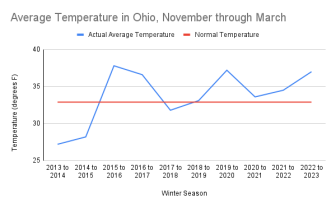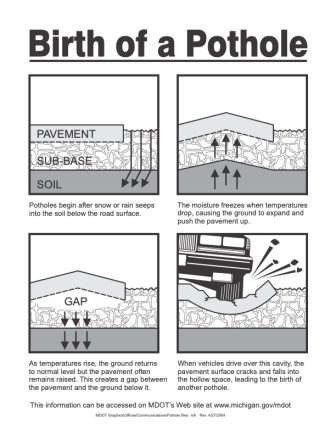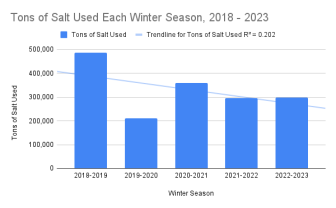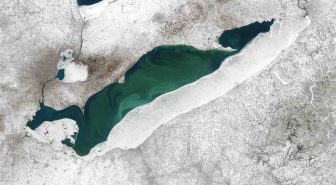
A plow clears heavy snow Hardin County, Ohio, February 2012. Image: Ohio Department of Transportation.
By Elinor Epperson
Winters keep the Ohio Department of Transportation so busy, they have a well-circulated joke about it: “If we’re not plowing, we’re patching,” said Matt Bruning, press secretary for the department.
The state maintains more than 43,000 miles of highway pavement that forms potholes as winter temperatures quickly rise and drop. Midwest news media call it winter whiplash.
Increased temperature and precipitation are challenging state agencies faced with maintaining safe and passable roads. The Ohio Department of Transportation is used to winter weather, but as winters grow warmer and more unpredictable, the long-term effects on pavement, culverts and bridges change as well.
Last December was the second warmest December in Ohio’s history, according to temperature data released by the National Oceanic and Atmospheric Administration (NOAA) in January. In contrast, January brought a ferocious mix of sleet, snow and freezing rain, closing schools and choking roadways.

The average temperature in Ohio between November and March has risen over the past 10 winters. Image: Midwest Regional Climate Center
Geddy Davis, an atmospheric scientist at the Byrd Polar and Climate Research Center at Ohio State University, attributed this to a mix of climate change caused by human activities and normal fluctuations in Earth’s climate each year.
“What was already anticipated to be a warmer than average winter was really kind of compounded from the effects of climate change that we have had a pulse on for quite a while,” he said.
El Niño, a natural warming of the Pacific Ocean, disrupts normal global weather patterns every few years. But climate data shows storms have gotten more severe, temperatures have risen and precipitation patterns have changed.
“There’s definitely some human influence,” he said. “[But] it also wouldn’t be quite as significant if we didn’t have the strong natural variation going on at the same time, too.”
Resilient Roads
Unusually warm or fast-changing weather wreaks havoc on transportation. Regional, state and municipal transportation agencies need to plan to be resilient. Roads, bridges, culverts and other highway structures need to be able to handle “excessive” rainfall, Bruning said.
“We’re always looking for how our infrastructure is least impacted by weather and climate,” he said. “Is it built to withstand extreme weather events?”
The biggest threat climate change poses to Ohio roads is increased flooding, the department reported in 2018.
As Ohio’s winters become warmer, it receives less snow and more rain. The rain may also be heavier, and severe storms could overwhelm waterways.
An earlier report recommended that the department hire someone to manage interdepartmental communications about climate change resiliency. Bruning is unaware of anyone whose only job is climate change resiliency, but the department has an Office of Environmental Services.
Bruning also said the department has been tracking and analyzing weather patterns for a while.
“Resiliency is nothing new to us,” Bruning said. Several hydrologic engineers calculate how much water volume a highway culvert can handle before it backs up and floods the road.
Tracking data, planning for increased temperature and precipitation and responding to increasingly strong storms are required to withstand changing climate, he said. But it is unclear if the department is taking any extra steps to prepare for climate change-induced hazards. Bruning said he hasn’t seen any drastic changes in winter road maintenance – yet.
Measuring winter whiplash
One way to measure how climate change affects roads is calculating the resources dedicated to maintain them. Pothole repair, salting and plowing are good indicators of extreme winters.
Potholes occur when the ground beneath the pavement freezes and then thaws, leaving a gap. Quick, extreme changes in temperature produce more freeze-thaw cycles – and more potholes.

A plow clears heavy snow Hardin County, Ohio, February 2012. Image: Ohio Department of Transportation.
“It’s the perfect weather for potholes to develop,” Bruning said. “That’s the situation we battle.”
Temperature data from the last five Ohio winters “look like a rollercoaster.” The state estimates it uses from 300,000 to 900,000 tons of salt per year. Personnel hours and asphalt used to patch potholes also vary, reflecting which winters were mild or particularly severe.

The amount of salt the Ohio Department of Transportation uses from year to year looks like a roller coaster. Over five winters, it has trended downward, but the sample is too small to represent a larger trend. Image: Matt Bruning, Ohio Department of Transportation
“It ebbs and flows,” Bruning said. He said he hasn’t seen a major change in salt use and pothole repair since he joined the department almost a decade ago. But the data show a downward trend in salt and asphalt use over five winters.
There aren’t enough data points to conclude anything – climate change is measured in decades and centuries, not a few winter seasons – but it supports predictions about where Ohio’s winters are headed.
“It’s always been part of the conversation,” Bruning said. “[But] it’s certainly getting more attention.”
What causes Ohio’s warm winters?
Davis, the atmospheric scientists at Ohio State, said it is unclear how much human-caused climate change influences warmer winters and creates winter whiplash.
“There’s a lot of connections to climate and climate change that still haven’t been sorted out yet.,” he said. “There’s a lot of work ongoing to determine how it impacts those Arctic outbreaks.”
But that does not mean climate change isn’t happening, he said. Further study is needed to determine how climate change and natural climate variance factor into extreme weather. The increase in temperature and precipitation “have been consistently observed for a while.”
Average temperatures across Ohio have increased by 1.2 degrees Fahrenheit since 1895, according to the University of Massachusetts Climate System Research Center.
All of these changes lead to the increased chance of flooding that the Ohio Department of Transportation needs to prepare for. Data from this winter so far indicate the warming trend is continuing.
Data from the last 10 years show annual precipitation in Ohio is creeping up, too. Projections by the National Oceanic and Atmospheric Administration predict that it could increase several inches by the 2090s, depending on how much global temperatures rise.

A satellite photo of Lake Erie’s ice as it melts in March 2010. Image: Coast Watch, National Oceanic and Atmospheric Administration.
Warming has also decreased ice cover on the Great Lakes. In years past, Lake Erie was usually frozen over by January.
“That normally cranks down the lake effect snow machine,” Bruning said. But over several decades, the lake’s ice cover has decreased. As the Great Lakes take longer to ice over due to warmer temperatures, lake effect snow arrives later..

The Great Lakes have experienced large variability in average ice cover since the National Oceanic and Atmospheric Administration started recording it in 1978, but the data trend downward over four decades. Image: Great Lake Environmental Research Laboratory, National Oceanic and Atmospheric Administration
A warmer Lake Erie water combined with Arctic cold weather systems leads to more lake effect snow. Climatologists expect overall snow accumulation to decrease as Ohio warms, but it could come in shorter, more powerful storms.
“Magnitude’s already difficult to predict as it is with natural cycles,” Davis said. “You add this extra element on top [climate change], and your envelope of possibilities expands dramatically.”
What is clear is that climate change makes it harder for scientists like Davis to determine why these swings in winter weather are happening. And that makes it harder for Ohio road officials to brace for what’s coming.
“There’s still plenty of variability that’s baked into all this,” Davis said. “And there’s a lot of research that still needs to be done.”